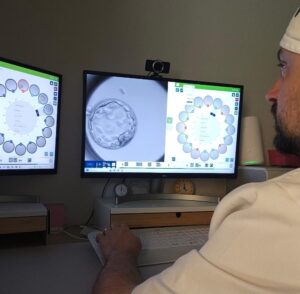The start of the covid-19 pandemic represented a turning point in the field of medicine. The situation triggered a multitude of studies aimed at finding solutions to contain the spread of the coronavirus. Some were looking, on the one hand, for vaccines to mitigate the effects and control the spread of the disease, and on the other hand, for diagnostic techniques that could be accessible to the world.
At first, PCR tests were one of the few techniques that provided accurate results, but it turned out to be a costly technique that required specialized personnel and equipment to perform. Due to the increasing demand for diagnostic tests, rapid antigen testing became a faster and cheaper alternative, but less reliable as it was less sensitive than PCR.
A new low-cost, portable, easy-to-use, and non-invasive device using light to perform covid-19 diagnostic tests on saliva samples in less than 30 minutes has been introduced.
In a new study published in the journal Biomedical Optical Express, researchers from ICFO and IrsiCaixa have developed a new device capable of detecting SARS-CoV-2 in saliva samples quickly and reliably.
The team managed to lower the sensor detection limit below that of antigen tests. By conducting a blind test with over 50 patients, they achieved a sensitivity of 91.2% and a specificity of 90%.
IrsiCaixa researchers and co-authors of the study, Marisa Rodríguez and Jorge Carrillo, point out: “We saw the need to find an alternative to PCR tests and antigen tests that combined the advantages and strengths of both tests, and that also detected SARS-CoV-2 infection from saliva samples, as they are easier to obtain and cause less discomfort to the patient.”
With this in mind, they contacted the ICFO team specialized in biosensor development, led by professor ICREA Valerio Pruneri and including Alfredo Ongaro, who recalled the need to develop a device that could detect SARS-CoV-2 from saliva samples, avoiding nasal sampling and providing precise results in a short period of time, as fast as antigen tests. It provides results in less than 30 minutes.
The team developed a flow virometer, a device that uses light to detect the virus concentration in a liquid flowing through a small tube called a microfluidic channel.
According to ICFO researcher Rubaiya Hussain, “the device uses a couple of saliva drops and fluorescent light markers. When patient saliva samples are collected, they are introduced into a solution containing fluorescent antibodies. If there are viral particles in the saliva sample, the fluorescent antibodies ‘attach’ to the virus.”
The sensor can detect very low concentrations of SARS-CoV-2 with a sensitivity of 91.2% and a specificity of 90%, similar to PCR but as fast as antigen testing.
After this, the saliva samples are introduced into the sensor and passed through a microfluidic channel under laser light – the researcher explains. The laser illuminates the sample, and if it contains viral particles, a signal is emitted thanks to the fluorescent marker. In less than a minute, the reader transmits the detected peaks of the signal to a graph and alerts the system that the sample is positive.
The ICFO team conducted a blind test of 54 samples provided by IrsiCaixa. The analysis confirmed 31 cases out of a total of 34 positives with only 3 false negatives. Additionally, they managed to measure 3834 viral copies per milliliter, about three orders of magnitude below those obtained with rapid antigen tests. This means that this device can detect the presence of the virus in very low concentration levels in a solution.
ICFO researcher and co-author of the study, Ewelina Wajs, points out that “our device is very versatile. By selecting the right antibodies, this technology could be adapted for the detection of other viruses, such as seasonal coronaviruses or the flu virus, or even microorganisms present in water bodies, such as Legionella or E. coli, with a faster response time than traditional culture-based analyses.”
With a single device, 2000 tests can be performed per day, it could be adapted to detect other microorganisms, and used for mass screening in public places without the need for specialized personnel.
The study authors emphasize that with a single device, it is possible to perform around 2000 tests per day. Additionally, they note that the device components are low cost and readily available in the market, allowing for large-scale production of the device. Furthermore, this technique could also help reduce the volume of waste generated by the plastic packaging of materials used in PCR and antigen testing.
Finally, due to its low cost and ease of use, the new sensor could be a solution for diagnostic processes and virus spread control in developing countries, where access to vaccines is limited and healthcare systems are fragile. The fact that this device does not have to be strictly used and handled by qualified personnel in a specialized laboratory would facilitate its use in mass screening tests in public places such as restaurants, schools, offices, theaters, and cinemas.
Source: MiMub in Spanish












